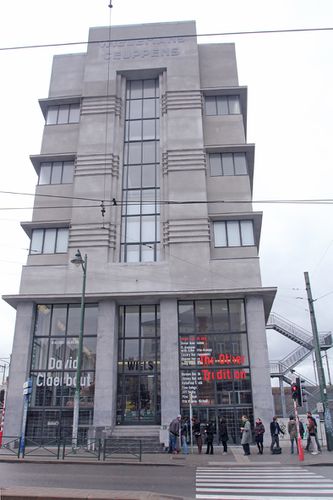Performance de Roman Ondák lors de l'exposition The Other Tradition au Wiels, Bruxelles, du 26.02 au 01.05.2011, Curatrice : Elena Filipovic
La contribution de Roman Ondák à The Other Tradition est peut-être l’œuvre la plus connue de l’artiste. Originellement montrée au Kunstverein à Cologne et
par la suite à la Tate, où elle fait désormais partie de la collection permanente, Good Feelings in Good Times (2003) consiste en une situation temporairement mise en scène dans laquelle des
personnes (minimum 6) doivent former une file d’attente à l’extérieur de l’institution artistique pour une période donnée durant toute la durée de l’exposition. Le résultat est à la fois
parfaitement banal et extraordinaire : une file de personnes rappelle le signe le plus ordinaire et frustrant de la vie moderne et, simultanément, sème le doute et signale l’attente de quelque
chose.
Même si Good Feelings in Good Times fait appel aux souvenirs d’Ondák, à savoir des files devant les magasins de sa Slovaquie natale durant l’ère communiste,
l’artiste souligne que la visualisation de la file d’attente est également l'objet d'une censure visuelle : dans la presse de l’ancien Bloc de l’Est, les représentations de files d’attente
locales étaient censurées et remplacées par celles du capitalisme occidental, représentant les personnes sans-emploi ou sans-abri attendant leur soupe gratuite.
La reconstitution d’une file d'attente devant une institution artistique occidentale recrée donc cette manipulation tout en produisant un commentaire critique sur
la production d’histoire. Simultanément, par les moyens les plus simples – quelques personnes restant debout à ne rien faire – l’artiste crée, quotidiennement, un acte de critique
institutionnelle, en déplaçant l’idée de la file d’attente typique d’un supermarché ou du bureau de poste, devant la porte d’une institution artistique.
La performance était visible aux horaires suivants:
Mer: 11.30 - 12
Jeu: 12 - 12.30
Ven: 12.30 - 13
Sam: 13 - 13.30
Dim: 14.30 - 15



Roman Ondák's Good Feelings in Good Times, 2003
The slippage between reality and fiction when seen through the lens of memory, the temporal inertia that accompanies anticipation, the potential for the recurrence of the past or even the future in the present: these are the intangible materials of so much of Roman Ondák’s (b. 1966, Slovakia) work. The use of these “materials” arguably emerges from and respond to the transformations of the political, economic, and cultural conditions of Eastern Europe in the wake of the end of communism. It is the context in which the artist came of age and, while he rarely refers to these conditions in any direct or explicit way, they are the foundation from which his work is best understood. His resultant varied oeuvre, including drawings, films, performance pieces, and installations, extend the vital legacy of Eastern European conceptual art practices, using everyday rituals and modest means to point to the space between art and everyday life, the private and the public, and the personal and the political or institutional.
Good Feelings in Good Times (2003), Ondák's contribution to The Other Tradition is perhaps the artist’s best known work. Originally shown at the Kunstverein in Cologne, and subsequently at the Tate, where it has become part of their permanent collection, it consists of a temporarily staged situation in which people (a minimum of six) are asked to form a queue outside the art institution for a fixed duration throughout the run of an exhibition. The result is at once utterly banal and totally extraordinary (after all, a queue of people remains the most frustratingly ordinary sign of modern life and yet, it invariably also leaves doubt that it signals an expectation for something—perhaps worth waiting for?). An avatar of anticipation, the queue has multiple meanings as a form. Even if Good Feelings in Good Times recalls Ondák’s memories of lines in front of shops in his native Slovakia during the communist era, the artist points out that the visualization of the queue was for a long time precisely the site of visual policing: in the press available in the former Eastern Bloc, depictions of local queues were censored, replaced in abundance with those from the West picturing capitalism’s unemployed in line or homeless waiting for their free soup. Ondak’s own reenactment of a line in front of Western art institutions thus slyly re-‐enacts these manipulations while commenting critically on the production of history. There is flip side too: through the simplest of means— some people standing around—the artist creates a spontaneous act of institutional critique, daily, by displacing the idea of a typical supermarket (or post office, or administrative office…) queue to the front door of an art institution.


